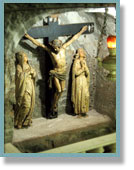 |
Some of the world’s greatest art treasures are based on
religious themes, with Jesus Christ being the theme and object
of many paintings, sculptures, and icons throughout the ages.
The cross has become a universal symbol of Christianity, and
the crucifix being a passionate symbol among the Catholic and
Orthodox religions.
The Cross as a Universal Christian Image or Icon
The cross is an outward sign of faith among many Christians;
however, one must consider what the cross really represents.
Does it represent the crucifixion of Christ only, or his
ministry as well? Can the cross capture the suffering of Jesus
in the Garden of Gethsemane? How does the cross represent the
resurrected Christ and his reigning on the right hand of God
today? Does our Heavenly Father want us to remember the cruel
instrument the cross was to his son, or does he want us
instead to focus on the living Christ and his presence in our
life today?
|
How Should we Remember Jesus Christ?
Christians may do well to consider if the cross should be a
symbol of faith in Jesus Christ, or rather should Christians
choose to quietly revere his suffering and resurrection in
their hearts and use life examples and actions as an outward
expression of faith? Covenants are made to take upon one’s
self the name of Christ at baptism, and the baptized life
should demonstrate the depth of keeping that covenant and
their love for the Savior.
Robert E. Wells of the Seventy addressed the issue of icons:
“We are Christians because, like the early Christians, we have
no graven images or any other objects of idolatrous worship.
(See Ex. 20: 4–6.) Nor do we feel that it is proper to make
medals, relics of ancient times, icons, or even the cross or
other man-made objects part of our worship of the true and
living God. Of course we adorn our parks and our buildings
with statues and we display pictures of the Savior and others
in prominent places, but we attach no undue religious
significance to such things made by man” (Elder Robert E.
Wells; “We are Christians Because…; Ensign, January 1984).
The apostle Bruce R. McConkie writes, “All the idols and icons
and images combined, since the world began until the end of
time, will never have power to cleanse and perfect a single
human soul” (Bruce R. McConkie, “The Lord God of the
Restoration,” Ensign, Nov 1980, 50).
What if no Religious Images or Icons are used?
On the subject of the absence of crosses and other such
symbols in LDS buildings the prophet Gordon B. Hinckley wrote:
“Following the renovation of the Mesa Arizona Temple some
years ago, clergy of other religions were invited to tour it
on the first day of the open house period. Hundreds responded.
In speaking to them, I said we would be pleased to answer any
queries they might have. Among these was one from a Protestant
minister. Said he: ‘I’ve been all through this building, this
temple which carries on its face the name of Jesus Christ, but
nowhere have I seen any representation of the cross, the
symbol of Christianity. I have noted your buildings elsewhere
and likewise find an absence of the cross. Why is this when
you say you believe in Jesus Christ?’”
“I responded: I do not wish to give offense to any of my
Christian colleagues who use the cross on the steeples of
their cathedrals and at the altars of their chapels, who wear
it on their vestments, and imprint it on their books and other
literature. But for us, the cross is the symbol of the dying
Christ, while our message is a declaration of the Living
Christ.’”
“The Protestant minister then asked: ‘If you do not use the
cross, what is the symbol of your religion?’ I replied that
the lives of our people must become the most meaningful
expression of our faith and, in fact, therefore, the symbol of
our worship.” (Gordon B. Hinckley, “The Symbol of Our Faith,”
Ensign, April 2005)
Conclusion
One should not criticize those who have a preference for
crosses, crucifixes, and other physical symbols of
faith—either worn on their body or displayed in their home.
Individuals should use whatever means is most effective in
their own lives to remember and revere Jesus Christ. There are
millions of Christians of all denominations who love to visit
Catholic Churches around the world and admire the astounding
beauty of the décor and feeling of reverence that such décor
promotes.
At the same time, one can’t help but appreciate the simplicity
of churches that do not have such décor and instead focus on
the living Savior and promote a reliance on one’s own faith in
developing a more intimate relationship with our Heavenly
Father and Jesus Christ. Imagine how wonderful our world would
be if all Christians made sure the lives they led were the key
outward sign of our faith in Jesus Christ as opposed to a
cross on a piece of jewelry.
Doctrinal
Study: Church
Practices: Images and Icons
 Download the
Sword Series™ essay on Images and Icons
Download the
Sword Series™ essay on Images and Icons |
